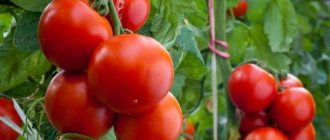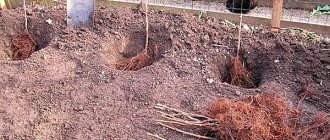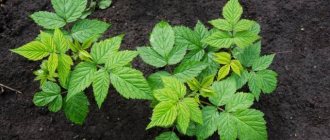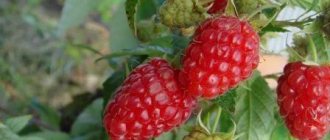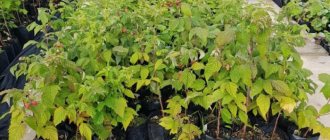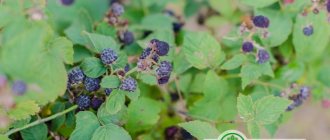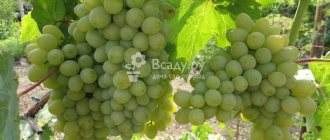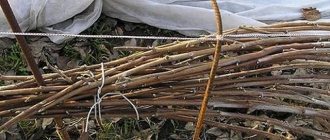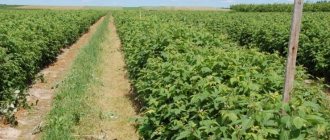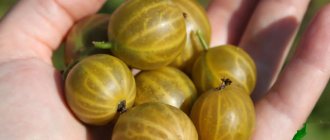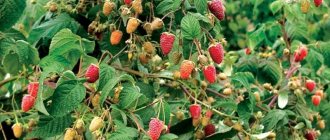Remontant varieties
Remontant raspberries have a distinctive feature - repeated fruiting.
And some modern types are able to delight with fragrant fruits all season long. Fruit ripening begins in mid-summer and ends in September - October. Autumn berries are larger and more fragrant. Knowing this ability, some gardeners mow plants in the spring at the root. Young shoots that grow over the summer give a bountiful harvest.
A brief description of:
- “Brusvyana” is an invention of our biologists. The bush is highly branched and tall (up to 2 meters). The shoots stand straight, there are few thorns, it is convenient to harvest. Brusvyana has a classic raspberry color and taste with decent weight (up to 12 g). The shoots are completely covered with fruits.
Agricultural technology:
- loves sunny areas sheltered from the wind;
- regular loosening of the soil;
- regular feeding;
- needs protection from diseases and parasites;
- bend down for wintering.
Raspberry brusvyana (loves sunny beds)
- "Yellow Giant" Harvest - 6 kilograms per plant. The fruits do not fall off and tolerate transportation well. The height of the plant exceeds 2 meters, and is used in the decoration of gazebos and alleys. The giant is frost-resistant and resistant to sores. A good choice for people with allergies and small children. The yellow giant does not cause allergic reactions.
Agricultural practices include regular watering and fertilizing, post-harvest cutting at ground level and mulching.
Yellow Giant (great for allergy sufferers)
- "Bryansk miracle" Ripens in mid-August, harvesting continues until frost. Divo has a bright red color and an elongated conical shape, with an average weight of 6 -11 grams. Harvesting from a bush is 4 kg. The fruits are sweet and sour.
Specificity of cultivation:
- the plant loves sunny areas and does not tolerate waterlogging of the soil, its roots rot;
- needs loose soil, regular fertilizing with humus or manure;
- in July, add 0.5 liters of ash under each bush to increase productivity;
- To enlarge the berries, the lower branches with buds should be removed before flowering.
Raspberry variety Bryanskoye Divo (ripens in mid-August)
- "Diamond". The plant is not tall, 140 centimeters. There are no thorns on the trunk. Berry size 6 grams. With proper care, 8 kilograms of berries can be harvested from one bush. Tolerates transportation and storage. If the temperature is constantly maintained within 5 degrees Celsius, the presentation is not lost for several months.
Agricultural technology:
- plant in sunny areas without covering the root collar with soil;
- bears fruit on black soil without any problems, but clay soil needs to be fertilized regularly;
- requires a garter.
Diamond raspberries definitely need to be tied up
- "Polka". A late species popular among gardeners. Increased productivity. Fruiting begins in mid-summer and does not stop until frost. A good option for industrial cultivation and for homestead farms. Fruits weighing up to 12 grams. Color – purple. Pronounced aroma and taste. The plant is not susceptible to diseases and parasites. The fruits do not crack for a long time, are well preserved and transported.
Agricultural technology:
- plant in sunny areas;
- the composition of the soil is not important, the main thing is fertilizing;
- needs soil loosening and pruning.
Polka raspberry bushes begin to bear fruit by mid-summer
- "Hercules". It is not demanding in care, is frost-resistant, and is not susceptible to disease or pest attacks. The berries have a ruby color and a sweet and sour taste. The weight of the fruits is 6-10 grams, they are well stored and transported.
- "Monomakh's Cap". The plant looks like a small tree 1.5 meters high. Powerful, branched, low-thorn shoots droop slightly downward. The fruits are deep red in color, average weight 7 grams. If you follow the rules of agricultural technology, you can find real giants weighing 20 grams each. The yield per bush is on average 5 kg, sometimes 8 kg. The fruits are obtuse, slightly elongated, and easily removed. The taste is sweet, with barely noticeable sourness.
Growing rules:
- regular watering and fertilizing;
- thinning of root layers;
- removal of excess ovary;
- requires protection from viruses and diseases;
- autumn pruning at soil level followed by fertilization with ash and humus.
By observing the correct frequency and abundance of watering, it is possible to obtain large and juicy berries.
Raspberry Monomakh's Cap is large in size
Varieties of remontant raspberries for the south of Russia
Hot sun, rare rains, dry summers, early spring and late autumn - all this characterizes the climate of southern Russia. Therefore, the best raspberry varieties for the Krasnodar Territory and other southern regions should be drought-resistant, sun-loving and, of course, produce a good harvest.
The following is a description of domestic varieties of remontant raspberries, popular in the southern regions.
Crane
Early, high-yielding, up to 2 m high, compact bushes. There are few thorns.
The berries are large (3-3.5 g), beautiful, tasty, with delicate aromatic pulp.
Apricot
Yellow berries of the Apricot variety
The fruits are yellow, up to 3.5 g, juicy, tender, tasty in fresh and processed form. Raspberry jam from this variety produces a beautiful golden color. One plant produces up to 2 kg of berries.
The bushes are 1.3-1.6 m high, grow straight, have strong branches, and weak spreading. Definitely needs to be tied up.
The fruits are located almost along the entire length of the stem. Thorns are at the bottom of the branches.
Before winter, the shoots are mowed down.
Indian summer
Bush variety Indian Summer
The very first remontant variety, bred in the 70s of the last century.
The yield is average (1 kg per bush), the berries are dark, weighing up to 3 g. Height up to 1.7 m, spreading average, needs to be tied up. Sensitive to watering and fertilizing. The fruiting zone is 30-50 cm from the top.
They are grown like ordinary raspberries, yielding twice.
Indian Summer-2
This variety is a new word in Russian selection. Fruits on 2/3 of the stem. The berries are sweet, weighing up to 4 g.
Height up to 2 m, the bush is highly branched. Young shoots appear in small numbers, which makes maintenance much easier.
The harvest is obtained only on annual stems; in the fall, all shoots are removed.
Diamond
A distinctive feature is the complete absence of thorns. Bushes 1.2-1.5 m high have very strong branches. A garter to the trellis (a type of support) is definitely needed.
The berries are beautiful, large, sweet, with a pronounced aroma. A high-yielding variety that bears fruit until the first frost.
Eurasia
Early ripening variety. Drought resistant. The berries weigh up to 4 g, are dark in color, dense, and transport well. The taste is sour, there is no aroma.
Height – 1.3-1.6 m. Grows evenly, no need to tie it up. There are few thorns.
Firebird
Berries of the Firebird variety are juicy, brightly colored
High-yielding variety (2.2-2.5 kg per bush). The fruits weigh 4.3-4.6 g (there are up to 6 g), sweet and sour, dessert. The pulp is dense and does not flow. Plants are 1.6-1.9 m high, with mild spreading. The varietal feature is thin and soft thorns concentrated at the bottom of the shoot.
Very sensitive to high temperatures and drought, may die. Partial shade should be provided and planted on the north side of the house or near fruit trees. But it tolerates rainy weather well, the berries do not rot.
Penguin
The variety is early and is slightly susceptible to diseases and pests. The berries are large (6-8 g), sweet, dark crimson in color.
Height – 1.1-1.4 m. Does not require additional support, grows straight and compact. It is also called the raspberry tree and is suitable for creating a hedge.
Ruby necklace
Fruits of the Ruby Necklace variety
Mid-season, rarely affected by diseases and pests. The berries weigh 4-5 g, dense, beautiful, bright red. They do not grow smaller, even if there is not enough watering. Well transported.
Before frost, shoots are removed from the garden.
Orange miracle
Large-fruited variety (weighing up to 5 g, maximum reaches 10 g), producing bright yellow berries. It has a sweet taste and pronounced aroma.
Productivity – up to 2.5 kg per bush. Begins to bear fruit in mid-August. Before the first frost it gives away most of the harvest. The plant is powerful and needs staking.
Many foreign varieties have proven themselves well in the southern regions. For example, Polana (or Polka) of Polish origin pleases with its high yield, excellent taste, and long fruiting period.
Nowadays, it is not difficult to select remontant raspberry varieties for the Krasnodar Territory or other regions. After all, Russian breeders are constantly working to obtain new highly productive varieties adapted to different climatic zones.
https://fermer.blog/tag/sorta-maliny-dlya-yugahttps://agrognom.ru/berries/raspberry/remontantnye-sorta-maliny-dlya-yuga-rossii.htmlhttps://7ogorod.ru/plodovye- kusty/malina-remontantnaa-lucsie-sorta-dla-uga-rossii.html
Sweet varieties
Raspberry is a berry that attracts with its taste. Therefore, for home gardening, the sweetest varieties of remontant raspberries are selected.
A sweet variety of remontant raspberries is “Caramelka”. This is a semi-shrub. Its berries contain one and a half times more sugar than regular varieties of garden raspberries. Caramel is very frost-resistant, has super-yields and is considered an excellent purchase for private households. The height of the bush reaches no more than one and a half meters. From one plant you can collect up to 5 kg of berries, the level of frost resistance is down to minus 30 degrees.
Variety Caramel
A new variety with increased disease resistance is the remontant raspberry “Pohvalinka”. Its berries are large and long in shape. They have a pronounced aroma and sweet taste. Productivity can reach up to 10 kg. from the bush.
The Polka variety has excellent taste. This is a dessert variety, the bushes of which reach a height of 1.60 m and form few roots. The shoots are strong and do not sag as the fruit grows. The berries are very sweet, with a pronounced aroma. They are stored for a long time and transported well. The yield of one bush can reach 4 kg. This variety is not suitable for dry climates. In addition, it has low winter hardiness.
For small areas, you can choose the remontant variety “Firebird”. It is valued for its excellent taste. But there is a big disadvantage - poor productivity and transportability. This variety can only be grown for personal consumption. The yield of the bush is no more than 2.5 kg; ripe berries do not fall off. But berry picking must be done regularly. This variety performs very well in the southern regions. It is not resistant to heat, so the bushes must be planted in the shade.
Indian summer
This is the first variety of remontant raspberry bred in Russia. Designed for cultivation in the southern and central regions. The bush is spreading, quite tall and erect. The berries are medium-sized, round-conical or spherical in shape. With the onset of ripeness they acquire a dark crimson color. The taste is sweet and sour, but without a pronounced aroma.
| Purpose | Productivity (kg per bush) | Berry weight (g) | Bush height (m) | Maturation (period) | |
| 1-2 | 3-4 | 1,8-2 | Beginning of June – beginning of July. Early September – mid October | ||
The best varieties of garden raspberries for central Russia
Marlboro. The most common variety in the Middle Volga region. The bushes are strong and erect. The variety is winter-hardy and productive. When describing this raspberry variety, it is especially worth noting the large, round, bright red berries with a good sweet and sour taste. Harvest begins at the end of June. Consumption - fresh and for technical processing.
Usanka. Distributed everywhere, but rarely. The bushes are vigorous, spreading, with hanging stems. Productivity is high, winter hardiness is average. The berries are large, weighing 2.1-2.5 g, blunt-conical, dark red, with juicy and aromatic pulp, sweet and sour pleasant taste. The beginning of berry picking is at the beginning of July. Not transportable. Consumption - fresh and for technical processing.
Kuzmin's news. The bush is vigorous, almost erect. In the conditions of the Volga region it proved to be highly resistant and resistant to chlorosis. It surpasses all varieties bred in the middle zone in terms of yield.
Pay attention to the photo of this raspberry variety - its berries are large (2.5-3 g), dark pink, blunt-conical, pubescent, medium juicy, sweet and sour, good taste. Berries ripening - early July
Consumption - fresh and for technical processing
Berries ripen in early July. Consumption - fresh and for technical processing.
Spirina 14. Vigorous, erect bush; gives an average number of replacement shoots and root shoots. The variety is winter-hardy and productive. Early ripening, simultaneously with the Novost Kuzmina variety. The berries are medium-sized, weighing about 2 g, oblong, tapering towards the top, juicy, sweet, with tightly attached drupes. Consumption - fresh and for technical processing.
Crimson Mammut. It has recently begun to spread in the area. The bush is vigorous and erect. It produces many replacement shoots and offspring. This is one of the best raspberry varieties - winter-hardy and productive. The fruits are medium-sized, weighing 2-2.2 g, dark red, shiny, almost round in shape, with a good sweet taste. The drupes are tightly interlocked and firmly held on the stalk. Medium ripening. Consumption - fresh and for technical processing.
Wislukha. It has recently begun to spread in our area. The bush is vigorous, with hanging tips of the shoots; produces many replacement shoots and root suckers. This is one of the best raspberry varieties - highly winter-hardy and productive. The fruits are large, weighing 2.8 - 3.4 g, light red, egg-shaped, good sweet taste. Medium ripening. Consumption - fresh and for technical processing.
Varieties of raspberries with double berries
Double berries are a varietal characteristic, but sometimes this phenomenon occurs on bushes with large raspberries or early ripening varieties due to high humidity in the spring or a viral infection:
- Dvoinaya is a late-ripening Belarusian variety, the productivity of the bushes is high, up to 12 tons per hectare, but at the same time weak resistance to frost. The first fruiting produces amazing double berries.
- Giant is a remontant variety with very large berries, up to 15 g, respectively, and the productivity is very high, up to 12 tons per hectare. The peculiarity of the fruit is the formation of double ruby berries of an elongated oval shape.
- Patricia - with large berries, 11-14 g, is not classified as remontant, but fruiting lasts from June to the end of August; up to 5 kg of mature fruits are harvested from one bush per season, sometimes double.
- Volnitsa is remontant, with cone-shaped berries, often fused at the first fruiting, weighing 3-5 g.
Sometimes the berries of the Maroseyka and Krasa Rossii varieties can double.
Raspberries are the best varieties for Siberia. Varieties of remontant raspberries for growing in Siberia
After a short summer in Siberia, it is very difficult to achieve a high raspberry harvest. But there are varieties that, with proper care, can produce abundant fruit. Let's look at raspberry varieties for Siberia, which you should experiment with in your garden to choose the most optimal ones.
Growing remontant raspberries in Siberia
Breeders have already developed enough varieties of remontant raspberries for regions with harsh and long winters, which quickly begin to bear fruit and withstand extreme frosts. But choosing the right, or even the best, variety is not everything. To obtain good fruiting, you should adhere to the correct cultivation technology in this region of Russia.
Nurseries offer a wide selection of raspberries for growing in Siberia, which are characterized by such qualities as:
- frost resistance;
- resistance to diseases and pests;
- with rapid ripening of berries.
The main qualities of remontant raspberries:
- It bears good fruit and already in the year of planting pleases with the first berries;
- The shrubs differ from other varieties in their low size. The shoots of remontant raspberries are medium tall and short;
- Crops of this variety are resistant to major diseases and pests;
- Remontant raspberry varieties bred for Siberia tolerate extreme frosts with virtually no freezing. Therefore, raspberry fields do not need to be covered; only snow cover will be enough;
- The bushes bear fruit throughout the growing season, which is an indicator of a high yield.
Rules for growing in Siberia
To grow in Siberia, you need to follow special rules. Since the summer is short - there are still frosts in June, and frosts already set in in September - not all the berries have time to ripen.
To get the largest possible harvest, the following method is used. It consists of growing raspberries only on young shoots. Before winter, the stems are cut off completely so that in the spring a new bush will form again.
In general, the technology for growing remontant raspberries in Siberia is almost the same as in other climatic zones:
- Planting bushes should begin in the last month of spring. Experienced gardeners do not recommend planting in the fall. Due to the rapid onset of frost, the root system may not take root well;
- The place for the raspberry plant should be as bright as possible, protected from drafts and wind. It is better if there is a southern or south-eastern side of the site. If the raspberries are thickened or grow in semi-shade, then there is a high probability of raspberries becoming infected with gray rot. The taste of the berries will become sour, the fruits will be small;
- The soil needs to be well fertilized and loose. The more nutritious it is, the better the effect on productivity;
- Plants are planted in a hole 0.5 m deep. The distance between bushes is 70-80 cm. And the row spacing is 1.2 m;
- The soil between the bushes should be mulched with rotted sawdust, peat or humus. This way the nutritional values in the soil are better preserved;
- During the growing season, raspberries are fertilized three times. You can use organic fertilizers - mullein diluted in water, bird droppings. Or use purchased mineral complexes;
- Water raspberries 4-5 times per season and generously so that the fruits are larger and sweeter;
- The first collection must be timely. Raspberries should not overripe on the branches, otherwise they will lose their shape, taste and will not be preserved well;
- Raspberries should not be planted in an area where nightshade crops, blackberry bushes, or other raspberry varieties were grown the previous year;
- During prolonged cloudy and rainy weather, when there is no warming for a long time, a disease begins to develop rapidly - gray rot. To prevent it, you need to regularly inspect the branches of the plant. If infected, immediately cut them off with pruning shears or a sharp knife below the affected area.
Features of cultivation and care
Planting raspberries in Kuban can be done both in spring and autumn. The place should be open to the sun and, at the same time, have a barrier from the winds. In the fall, the area is cleared of plant debris, dug up and fertilized with humus (approximately 4 kg/1 m²).
The seedlings are not deeply buried: the root collar should be level with the ground. An interval of 1–1.5 m is maintained between several bushes, and 2–2.5 m between rows, depending on the variety. After planting, the plants are watered by pouring up to 10 liters of water under the bush.
If the weather in the area is dry and hot, then frequent and abundant watering is needed. The soil should be moistened to a depth of 40 cm. This is especially important during the formation of flower buds. Moisture-charging watering is also needed after harvesting so that the plant overwinters well.
Remontant raspberries, according to the description of the rules of its agricultural technology, do not need to be fed throughout the season, 2-3 times are enough. In the spring, this can be any nitrogen fertilizer: urea or mullein infusion. During flowering and fruiting - phosphorus-potassium complexes.
From early spring to late autumn, the tree trunk circle is loosened. Moisture must pass to the roots without obstacles, as well as oxygen, without which normal plant development is impossible. At the same time, weeds are removed so as not to thicken the planting.
If garters are necessary, a trellis is placed on a support next to the bushes. The wire is stretched at a distance between rows of 25–30 cm.
After getting acquainted with remontant raspberries, everyone will find those they like best in the list of varieties. In general, they all have more advantages than disadvantages, and are also undemanding in care.
Features of raspberry cultivation in the southern regions
The parental forms of raspberries of modern varieties originate from northern latitudes. This is precisely the reason why this crop is more frost-resistant than drought-resistant. It easily adapts to low temperatures, and a long spring and a short, cool summer are just what is needed for raspberries.
The specifics of growing remontant raspberries in the south of Russia, in particular in the Kuban, are determined by the climate, namely the early hot spring. After the end of winter, the temperature rises rapidly and often reaches 25-30 degrees by the end of April. Added to this are winters with little snow with frequent thaws and drying winds that take moisture from the soil, which often lacks a protective snow cover.
Numerous studies have shown that the main problem when growing raspberries in the southern regions is drying of the shoots, which sharply increases towards the end of winter. At this time, the plant is still dormant; the dry wind takes moisture from last year’s stems, as well as the top layer of soil, where most of the raspberry roots lie. Although its root system is well branched, it lies mainly at a depth of 30-40 cm.
This determines the requirements for the placement of raspberry plantings in the southern regions:
- Raspberry plantings should be well protected from the wind. They are best planted in areas surrounded by forests, in the steppe - under the protection of forest belts or gardens. In the North Caucasus, raspberries are best planted on the northern and western mountain slopes.
- Although raspberries are not as demanding on watering as black currants and do not like stagnation of water at the roots, the first condition for its successful cultivation is a sufficient amount of moisture in the soil throughout the entire growing season. In the southern regions, at high temperatures, this crop can be called extremely demanding of watering; there, raspberries will feel best in ravines or river valleys. In the North Caucasus, more precipitation falls in mountainous areas; industrial plantations or raspberry plots without artificial irrigation need to be established there.
- In the southern regions, plants receive a lot of ultraviolet radiation, while raspberries are native to the north and tolerate shading well in the North Caucasus. She feels good in the shade of trees, between outbuildings, in the shade of a house and will be content with a small amount of sunlight. In the sun, raspberry leaves turn yellow ahead of time, and the berries can “cook” without reaching marketable ripeness.
Based on the above, novice gardeners may have the brilliant idea of placing raspberries in the rows of the garden. Do not do that! Raspberries can produce many root shoots and quickly clog the garden. At the same time, it can go wild, and it will be difficult to fight the shoots without disturbing the root system of fruit trees. The yield of wild raspberries will be ridiculous, but it will draw nutrients from the top layer of soil and will also complicate planned treatments for diseases and pests, as well as harvesting.
In the southern regions, raspberries should be planted in the fall, preferably after the end of Indian summer. Even the most resistant varieties will not have time to take root if the temperature rises rapidly in the spring - neither frequent watering nor treatment with stimulants will help. As a rule, at high temperatures, spring plantings do not survive until summer.
Important! To summarize: in the southern regions, raspberries need a place protected from the wind and excess sunlight (or shaded) and frequent heavy watering
This is interesting: Raspberry Ruby necklace
Let's sum it up
Remontant varieties have a number of undeniable advantages over traditional varieties.
With a one-year growing cycle, we get the opportunity to have a harvest at a time that is unconventional for raspberries; raspberries ripen in the absence of the scorching sun, which is the main advantage in the south. By cutting off the shoots for the winter, it is possible to rid it of diseases and pests that overwinter on the bushes.
With a two-year cycle, amateurs have the opportunity to get two harvests per season, and this, you see, is very attractive for every gardener.
The rules for growing remontant raspberries can be found in the video:
If you decide to plant raspberries in your summer cottage, carefully choose the variety. Read the description of all possible options and reviews from summer residents. After all, there are varieties that are suitable for cultivation in various regions - from the Urals and Moscow region to central Russia and Kuban.
Early ripe raspberries are planted, as a rule, in the southern regions of our country, where they delight summer residents with ripe berries already at the end of May, and in the regions of the north-west and central Russia, raspberries begin to bear fruit in June.
Although early raspberry varieties are not as productive as late raspberries, early ripening increases their commercial value.
The most productive varieties
A variety with a productivity of 3 kg per bush is considered productive. Large-fruited varieties produce high yields, but require more attention. Remontant varieties of raspberry berries are less demanding in care. Experienced gardeners grow several different varieties, but not in one place.
Bryansk miracle
Remontant, with high productivity of about 3 kg per bush. Frost-resistant, disease resistance is mediocre. Does not require insulation, because shoots are cut completely to ground level in winter.
The bush is medium, about 180 cm. Does not require support. Fruiting begins in mid-August. The berries are bright red, weighing about 11 g and 4 cm long. They have the shape of a cone. The pulp is dense, sweet with a sour note. This variety is suitable for transportation, freezing and preservation.
Find out more about the Bryanskoye Divo raspberry.
Hercules
Remontant raspberry Hercules, high-yielding, approximately 4-4.5 kg per bush. Frost resistance is low; winter insulation is required. Good immunity to common fungal diseases and raspberry mite. Bushes up to 200 cm, with medium spreading. Does not require garter or support.
Fruits from mid-June until late autumn. The berries are a beautiful ruby color, in the shape of a cone. The average weight is 7 g, but with proper agricultural technology they can grow up to 15 g. The taste is sweet and sour, with dense juicy pulp. They tolerate transportation well over long distances.
Hussar
Remontant, with a yield of 4 to 6 kg per bush. Tolerates temperature changes and drought well. Resistant to viral diseases. In winter it is completely pruned and does not require insulation.
The bushes are large, with medium spreading. They grow over 230 cm. Very powerful stems, almost without thorns. No garter needed. Fruits in the first half of summer.
Find out what are the features of growing Gusar raspberries.
The fruits are large, about 12 g, garnet-colored. Elongated, conical shape. Sweet, with pronounced sourness. The pulp has a dense structure. They have good transportability.
Yellow giant
Semi-repairable, with excellent yield of about 6 kg per bush. Resistant to diseases and pests. In unstable winter temperatures, insulation is required. The bushes are tall, reaching 250 cm. Very spreading, with weak branches. Support is needed.
Check out the Yellow Giant raspberry variety.
Harvesting can begin in mid-June. The berries are large, yellow with an amber tint and weigh 12 g. The shape is cylindrical. The pulp is very juicy and sweet, with a loose structure, so the berries are not stored for a long time and cannot be transported.
Giant
Remontant, with a high yield of up to 10 kg per bush. With stable immunity to severe frosts and diseases. The bushes are medium, up to 180 cm. The branches are without thorns. A garter and support are needed. Fruits in early July. The berries of the Giant variety weigh about 15 g and are 5 cm long. Oblong, cone-shaped, rich red color.
The pulp is dense, juicy with a sweet and sour taste, similar to wild berries. Can be transported
Having familiarized yourself with the five best varieties of large-fruited raspberries with high productivity, you can choose the one that suits your taste and, by paying due attention to the culture, provide yourself and your loved ones with healthy and tasty berries grown with your own hands. Have a good harvest!
Varieties of varieties depending on ripeness period
Berries are also classified according to their ripening time.
Early varieties
Early raspberry varieties begin to bear fruit from the second half of June until the 1st decade of July on old, two-year-old shoots. These include:
- Scarlet sails - the fruit size is small, up to 2.7 g, but frost resistance and yield (up to 2 kg) are high. The shoots are highly branched, but with fewer thorns.
- Bryanskaya - stems are strong, lightly branched. The berries are tasty, medium-sized, up to 3 g. Based on the number of berries collected per season, they are classified as medium-yielding. Average resistance to diseases.
- Lazarevskaya - bushes are distinguished by the height of their shoots, which do not exceed 1.8 m, branched. The berries are larger than average, up to 3.5 g, and up to 2.2 kg are harvested from the bush per season. Not suitable for long-term transport. Does not tolerate severe frosts and requires shelter. Often exposed to diseases.
- Meteor - begins to bear fruit very early, in the second half of June with medium-large berries up to 3 g. Harvest is friendly, up to 2.5 kg. It is almost not affected by fungal diseases and is attacked by pests. Tolerates winter frosts well.
- Kuzmin's news - with an average yield, the variety is characterized by increased resistance to many diseases and pests, sudden temperature changes, and harsh winters.
Also included here are: Novokitaevskaya, Vega, Solnyshko, Michurinskaya dessert, Early dawn, Early surprise, Flame, Early sweet.
Medium ripening
Red raspberries with an average ripening period begin to ripen from the beginning of June until the second half of August; they include mid-early and mid-late varieties, for which the time may shift depending on weather conditions and the region of growth:
- Balsam - tolerates northern winters favorably, the shoots do not rot or dry out. The berries are larger than average, up to 2.8 g, yield up to 2.2 kg. Rarely exposed to pests and diseases.
- Gloria - the bushes are very tall and spreading, strong. The berries are large in size, up to 4 g. The harvest is up to 90 kg per 1 acre. Resistance to diseases and frost is average.
- Shy - compact bushes, thorns are very rarely seen on the branches. Weather changes do not affect the amount of harvest; it is always stable, with medium-sized berries, up to 2.9 g. The main pest is spider mites. It exhibits strong immunity to fungal diseases.
With an average maturity period, the following varietal red raspberries are distinguished: Kaliningradskaya, Vislukha, Glen Prosen, Cleopatra, Glen Ampl, Gloria, Volnitsa, For Zdravie, Gusar, Iskra, Kirzhach, Tenderness.
Late
Ripening of late varieties of red raspberries begins in August:
- Brigantine are compact shrubs from which up to 2.2 kg of large berries, more than 3 g, are harvested. The taste quality received a tasting rating of 4. Winter hardiness and the possibility of infection with diseases are average.
- Rubin is a Bulgarian variety with high taste and characteristics, very large fruits, sometimes reaching 4 g. Fruiting is stable even in the presence of diseases to which there is weak immunity. Winter hardiness is average.
- Companion - with good tolerance and susceptibility to diseases, the bushes exhibit an average degree of resistance to frost, although the fruits reach a weight of 3.5 g and a yield of up to 2 kg.
Peresvet, Mirage, and Stolichnaya ripen later than other varieties of red raspberries, starting in the first or second decade of August.
Repairers
Varieties of remontant red raspberries are distinguished by a long fruiting period and high yield of bushes, as well as a lower incidence of diseases. Thanks to them, you can eat berries throughout the summer and autumn:
- Penguin - ripens from June on compact bushes with large berries up to 5 g, high productivity, up to 2.5 kg per bush. Highly winter-hardy, the main pests and diseases of the Rubus genus almost do not affect.
- Hercules - from August until the first frost, the crop produces up to 80% of very large ripe berries, the productivity of the bushes is up to 2.5 kg. It has high levels of immunity against diseases and pests.
- Kalashnik is a high-yielding plant, up to 3 kg, with unusual taste qualities of medium-sized fruits, up to 3 g. It favorably tolerates frost of -30, dry weather, and major diseases.
Indian Summer, Indian Summer 2, Bryansk Jubilee, Mulatka, Eurasia - remontant varieties with large red fruits.
